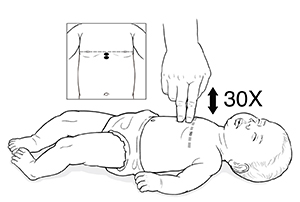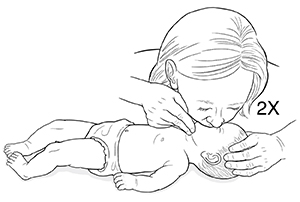Choking First Aid (Infant, Up to Age 1 Year)
Choking happens when an object gets stuck in the throat or airway. This can block the flow of air and cut off oxygen to the brain. Your baby will have a weak cough and trouble breathing or noisy breathing.
Young babies may choke if they swallow breastmilk or formula too quickly or if they have too much mucus.
Any object small enough to go into your baby's airway can block it. This includes small food pieces, like nuts, grapes, beans, popcorn, hotdogs, or food that hasn’t been chewed well. Household objects like buttons, marbles, coins, latex balloons, and beads are also common choking hazards. Small toy parts can also cause your child to choke.
If your baby is choking, give first aid right away. This will clear the airway so your baby can breathe.
Signs of a blocked airway
These are signs of choking:
-
Violent coughing
-
A high-pitched sound when breathing in
-
Your baby can’t cough, breathe, or cry
-
Face turns pale and bluish
At the first sign of choking
If your baby is conscious, having troublebreathing, and can’t cry or make sounds, start first aid for choking right away. This will clear the airway. Follow these guidelines:
-
Don't put your finger into the baby’s mouth to remove the object. Your finger could push the object farther into the baby’s throat.
-
Have someone call 911 if you're not alone.
-
Sit down. Then lay the baby stomach-down along your forearm. Support the baby’s face (head) and neck in your hand. If you need to, support your arm with the baby along your thigh. Make sure the baby’s head is slightly lower than the rest of their body. This will help dislodge the object more easily from the throat.
-
Use the heel of your free hand to give 5 quick thumps (back blows) between the baby’s shoulder blades.
-
If the object is still lodged, turn the baby face up on your forearm. Support the head. Place 2 or 3 fingers in the middle of the baby’s breastbone. Push down about 1/2 inch to 1 inch. Do this 5 times fast.
-
Check the baby’s mouth to see if the object is dislodged. If not, repeat steps 3, 4, and 5 until the baby’s airway is clear and the baby is breathing normally.


If your baby is not breathing, becomes unconscious, or is unresponsive, follow these guidelines if you are not alone:
-
Have someone call 911 right away.
-
Lay the baby on a firm, flat surface, such as a table, the floor, or the ground.
-
Start infant CPR (cardiopulmonary resuscitation):
-
Give 30 chest compressions. To do this, use 2 fingers to gently push down on the center of your baby’s chest, just below the nipple line. Push in about 1.5 inches. Do this 30 times fast. It should take about 20 seconds.
-
Tilt the baby’s head back and chin down. Check inside the mouth for an object. If you see it, carefully try to sweep it to the side. Be very careful to not push it further into the throat.
-
Give 2 rescue breaths. To do this, gently lift the chin up with 1 hand and tilt the head back. Cover your baby’s mouth and nose with your mouth. Gently give 2 puffs of air into your baby’s mouth and nose. Each breath should take about 1 second. Watch to see if the baby’s chest rises.
-
If the baby doesn’t start breathing, do another 30 chest compressions followed by 2 rescue breaths.
-
Continue CPR ( repeat all of step 3) until emergency service arrives or your baby starts breathing.
If your baby is not breathing, becomes unconscious, or is unresponsive, follow these guidelines if you arealone:
-
Lay the baby on a firm, flat surface such as a table or the floor or ground.
-
Do CPR for 2 minutes (5 cycles):
-
Give 30 chest compressions. To do this, use 2 fingers to gently push down on the center of your baby’s chest, just below the nipple line. Push in about 1.5 inches. Do this 30 times fast. It should take about 20 seconds.
-
Tilt the baby’s head back and chin down. Check inside the mouth for an object. If you see it, carefully try to sweep it to the side. Be very careful to not push it further into the throat.
-
Give 2 rescue breaths. To do this, gently lift the chin up with 1 hand and tilt the head back. Cover your baby’s mouth and nose with your mouth. Gently give 2 puffs of air into your baby’s mouth and nose. Each breath should take about 1 second. Watch to see if the baby’s chest rises.
-
If the baby doesn’t start breathing, do another 30 chest compressions followed by 2 rescue breaths.
-
Call 911 after the 5th cycle.
-
Continue CPR (repeat step 2) until emergency service arrives or your baby starts breathing.
 |
| Chest compressions. |
 |
| Rescue breaths. |
If you are alone, not trained in CPR, and are near a phone, call 911 right away.
Prevention
If your child has choked, try to find the cause to prevent future problems:
-
Watch your child during meals. Children should sit down to eat. Cut food into small, bite-sized pieces.
-
Check each room in the house every day for small objects like buttons, coins, and toy parts.
-
Choose large, sturdy toys that don’t have sharp edges or small, removable parts. Safe toys are those that won’t fit into a toilet tissue roll.
-
Check toys often for loose or broken parts.
-
Remove drawstrings from clothing. Don't tie balloons, long strings, or ribbons near a crib.
Follow-up care
Follow up with your child’s healthcare provider as advised.
Special note to parents
Anyone caring for an infant should learn infant or child CPR. Ask your child’s provider about CPR classes in your area.
Call 911
Call 911 if any of these occur:
-
Continued choking or trouble breathing
-
Wheezing or any abnormal breathing noises after a choking incident. An airway that is partly blocked can become fully blocked.
-
Skin, lips, and nails look blue or darker than normal (dusky)
-
Is unresponsive or not alert